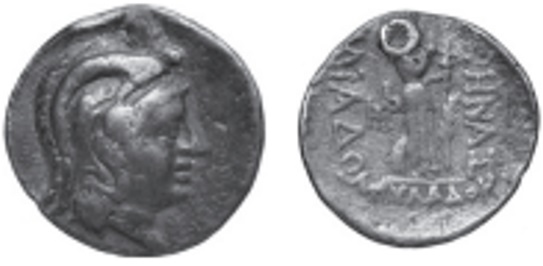Ilium, silver, drachms (90-50 BCE)
From SILVER
90 BCE - 50 BCE Silver 1,616 kg
Description
| ObverseInscription or printing placed on the obverse.: | Laureate head of Athena right, wearing crested Attic helmet |
| ReverseInscription or printing placed on the reverse.: | AΘΗΝΑΣ ΙΛΙΑΔΟΣ (Greek).Athena Ilias standing right, holding distaff and spear, at her feet to right, owl standing right, head facing |
Mint and issuing power
| MintIdentifies the place of manufacture or issue of a numismatic object.: | Ilium | Ancient regionAncient region.: | Troas | Modern countryModern country: Turkey | AuthorityIdentifies the issuing power. The authority can be "pretended" when the name or the portrait of X is on the coin but he/she was not the issuing power. It can also be "uncertain" when there is no mention of X on the coin but he/she was the issuing power according to the historical sources: | League of Athena Ilias |
Chronology
| FromIdentifies the initial date in a range assigned in a numismatic context. | 90 BCE | toIdentifies the final date in a range assigned in a numismatic context.. | 50 BCE | PeriodTime period of the numismatic object.: Hellenistic 323-30 BC |
Physical description
| MetalThe physical material (usually metal) from which an object is made.: | Silver |
Median weightMedian of the weights of numismatic objects (in grams). in grams | 3.50 | DenominationTerm indicating the value of a numismatic object. Examples: tetradrachm, chalkous, denarius.: | drachm | StandardStandard.: | Attic |
References
| Die study referencePublication of the study: | Ellis-Evans 20161Ellis-Evans 2016 | ||
| Coin series referenceReference to coin series study: | |||
Obverse dies distribution
| FrequencyFrequency of specimen in distribution. ᵖ | Number of obversesNumber of obverse dies. ᵖ (o) | % (o) | Number of coinsNumber of coins. (n) | % (n) | Die nameName(s) of the die(s). |
| 1 | 4 | 80 | 4 | 66.67 | A, B, C, D |
| 2 | 1 | 20 | 2 | 33.33 | E |
| Total | 5 of 5 | 100 | 6 of 6 | 100 |
Reverse dies distribution
no distribution is available
Quantification
| Number of obversesNumber of obverse dies. ᵖ (o) | 5 | Number of singletons (o1)The number of singleton coins. ᵖ | 4 |
| Number of reverse diesNumber of reverse dies. (r) | 5 | Number of coinsNumber of coins. (n) | 6 |
| Coins per obverse dieNumber of coins per obverse die. (n/o) | 1.2 | Coins per reverse dieNumber of coins per reverse die. (n/r) | 1.2 |
| Reverse per obverse ratioRatio of obverse dies divided by reverse dies. (r/o) | 1 | Percentage of singletons (o1)number of coins (n) divided by the number of singletons (o1) ᵖ | 80 % |
| Original number of dies (O) (Carter 1983 formula)The estimation of the number of coins according to Carter 1983 ᵖ | 23.09 | Coins struck if 20,000 as average productivity per dieCoins made if the average productivity for obverses (according to Carter) is 20,000. ᵖ | 461,800 |
| Original number of dies (O) (Esty 2011 formula)The estimation of the number of coins according to the singleton formula in Esty 2011 ᵖ (O) | 30 | Survival rate if 20,000 as average productivity per dieSurvival rate if average productivity is 20,000. ᵖ | 0.00001 |
| Coverage (o = % of O) (Esty 1984 formula)Esty 1984 - coverage (% of O) ᵖ (o = % of O) | 33.33% | Die productivity if survival rate 1/2,000Average productivity if survival rate is 1/2,000. ᵖ | 519.71 |
| Weight of silver (in kg) if 20,000 coins per die (O = Carter formula)Carter 1983 * Median weight * 20000 (*10 if gold or electrum) ᵖ | 1,616 kg <br /> 1,616 kg | Die productivity if survival rate 1/5,000Average productivity if survival rate is 1/5,000. ᵖ | 1,299.26 |
Remarks
Most likely one single workstation
References
- ^ Ellis-Evans, Aneurin (2016), "The Koinon of Athena Ilias and its Coinage", American Journal of Numismatic, 28, p. 105-158, pl. 36-46.
